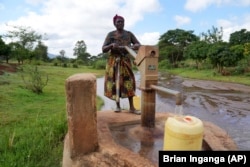In southeastern Kenya earlier this year, people from Kasengela village built a special kind of dam. The barrier is called a sand dam. It reduces water flow and increases the amount of wet sand behind it.
Sand dams are becoming more common in Kenya and other countries. Local people say the dams save time and labor because they can get water more easily during dry seasons.
Kyalika village in Makueni County is where Rhoda Peter and her group built three sand dams along a nearby river.
“When I think about sand dams, I feel happy,” said Peter, a farmer. “Our shallow well does not dry. It goes all through the dry seasons.”
Before they built the dams, she and her children would walk many kilometers to get water. It took them three hours, and they would hurt their feet on rocks.
Mwanzia Mutua is the leader of the group who built the Kasengela dam. He said that he used to walk seven kilometers from his home to the Athi River to get water. He spent a whole day on the road. The sand dam will reduce the walk to 10 minutes, he said.
“When water is far, you spend all your time looking for it and are unable to do any other work,” said the farmer. “Cattle die because the water is far.”
How the dams work
In Kenya, rain falls only part of the year. Some rivers become dry soon after the rains stop. However, these rivers have a sandy bottom, and the sand can hold water.
The dams are made of concrete and block some of the sand and water. As a result, wet sand builds up behind the dam. This sand can hold enough water for people to use during dry weather. To get the water, they use a hand pump to pull water from the sand.
Experts say the dams also help area plants grow and add to groundwater.
However, sand dams only work in some areas. A study in Kitui County found that about half of 116 sand dams were not working. The study said the amount of rainfall, and the amount of clay and rock in the soil are important.
“You cannot put a sand dam anywhere,” said Keziah Ngugi, a hydrologist and lead writer of the study.
Growing numbers
Makueni County has nearly 245,000 households. But clean piped water reached only five percent of them in 2022.
That is one reason the Makueni County government has been building sand dams with partner organizations and local groups. By 2022, it had built 71, county government records show.
The Africa Sand Dam Foundation (ASDF) helped build the dams in Kyalika and Kasengela. The communities provide sand, rocks and other locally available material, and labor. The British nonprofit uses partners to provide cement and workers with special skills. After building is complete, the community oversees the sand dam.
Since it started in 2010, the nonprofit has helped build 680 sand dams in three counties.
“We’ve used this model for years, and we’ve seen its success,” said Andrew Musila. He is development director at ASDF.
The organization has also worked with governments and other nonprofits in Malawi, Zimbabwe, Mozambique, Madagascar, Eswatini, Ethiopia, Tanzania, Somalia and India.
The sand dam in Kasengela was completed on March 14, and should be ready to use by December 2025, after it fills with sand.
I’m Andrew Smith.
Carlos Mureithi wrote this story for The Associated Press. Andrew Smith adapted it for VOA Learning English.
________________________________________________
Words in This Story
shallow –adj. not deep; not involving a lot of water
clay –n. a kind of soil made of very fine particles that are tightly packed together
hydrologist –n. a person who studies water













Forum